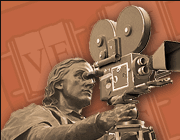MAKING A SCHOLARLY SHORT IN 3 EASY STEPS
There is a very easy way to make a compelling scholarly short, and it consists of three simple steps.
- prepare a Keynote or Powerpoint presentation of your ideas
- record your narrated presentation with a video capture program
- export the recorded presentation as a movie (.mov or .mp4) file.
That’s it!
Students in the past have of course also made great movies using iMovie (free on Mac) , Vegas Studio (Windows, $45), and more advanced video editing programs such as Final Cut and Adobe Premier; but it’s entirely possible—and often easier—to make great scholarly shorts following the steps above.
What Video Capture Program Should I Use?
Camtasia 2 ($75 (with educational discount) may be the best of the current video capture programs. The program is easy to learn (the makers provide a set of online tutorials) and intuitive to use, and is remarkably versatile and powerful. Versions are available for both the Windows and Mac.
Snagit ($29.95) and Jing (free), are more basic, but cheaper capture programs from the same maker.
Screenflow ($99, minus 10% education discount) is also an excellent program for Macs, and installed on the Macs in the Media Lab in Lamont Library.
All of the above programs allow for free trial downloads.
RESOURCES
Please check out the Multimedia Resources and Computers Website for information on various multimedia resources and the Collaborative Research Space in Lamont.
SOFTWARE TIPS
You can work with two of the most powerful video editing programs, Final Cut Pro and Adobe Premier, in the Media Lab of Lamont Library (room A-10). The Media Lab also provides access to the remarkable special effects program, After Effects. The Media Lab offers free access to lynda.com, which has introductory to advanced tutorials on all these and other useful programs (like Photoshop). Video Co-Pilot's introductory tutorials on After Effects can be viewed here.
You should know, though, that excellent movies can be made with much simpler programs such as iMovie (Mac) and Vegas Movie Studio HD11 (Windows). An even easier--and for scholarly analyses, often just as effective approach--is to compose a multimedia presentation on Powerpoint or Keynote, and then to record the narrated presentation using Jing (free) or Screenflow (available in the Lamont Media Lab).
KEYNOTE TUTORIALS
- Keynote tutorials at Apple
- Look particularly at "Using advanced builds to animate objects" to study how to move objects onto and off slides
- ADDITIONAL KEYNOTE PRESENTATION TECHNIQUES provided below courtesy Prof. Shigehisa Kuriyama:
KEYNOTE PRESENTATIONS TECHNIQUES
|
|
Directing attention with pointing arrow.
|
|
|
Encompassing an object with an oval. (No narration or titles; just follow the steps traced by the cursor. It may be helpful to watch the Techniques 1 tutorial first)
|
|
|
A tutorial on how to focus attention by creating a shifting spotlight-like effect.
|
|
|
How to zoom in on one portion of an image
|
IMOVIE TUTORIALS
- Apple Tutorials for iMovie 09
- Editing video clips in iMovie HD
- Harvard Extension School tutorial on using iMovie HD. NOTE: Best to stay with iMovie 09.




